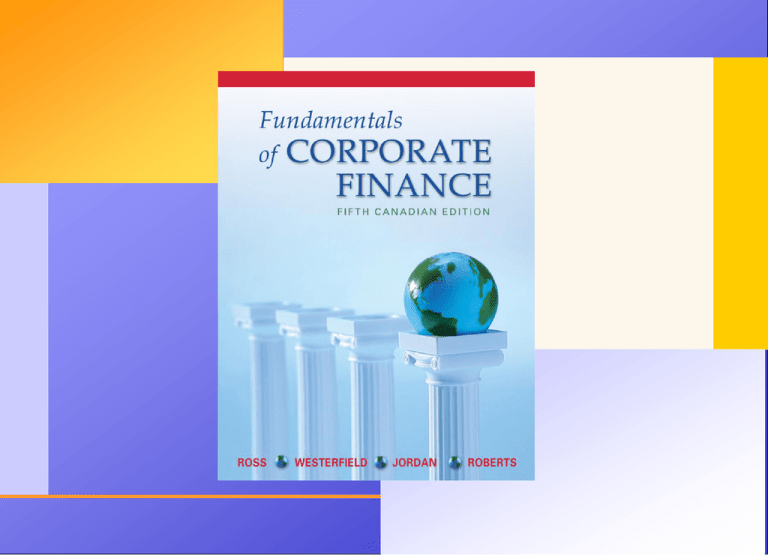
© 2005
McGraw-Hill
Limited
© 2003 The McGraw-Hill
Companies,
Inc. AllRyerson
rights reserved.
The University of Lethbridge Faculty of Management
Management 3040 – Finance
Terry D. Harbottle
© 2003 The McGraw-Hill Companies, Inc. All rights reserved.
1.1
Chapter 1 - Key Concepts and Skills
• Know the basic types of financial management
decisions and the role of the financial manager
• Know the financial implications of the different forms
of business organization
• Know the goal of financial management
• Understand the conflicts of interest that can arise
between owners and managers
• Understand the various types of financial markets and
financial institutions
• Understand current trends in Canadian financial markets
© 2005 McGraw-Hill Ryerson Limited
1.2
Chapter Outline
•
•
•
•
•
•
•
Corporate Finance and the Financial Manager
Forms of Business Organization
The Goal of Financial Management
The Agency Problem and Control of the
Corporation
Financial Markets and the Corporation
Financial Institutions
Trends in Financial Markets and Financial
Management
© 2005 McGraw-Hill Ryerson Limited
1.3
Corporate Finance
• Some important questions that are answered
using finance
– What long-term investments should the firm take
on?
– Where will we get the long-term financing to pay
for the investment?
– How will we manage the everyday financial
activities of the firm?
– How can we manage financial and market risk?
© 2005 McGraw-Hill Ryerson Limited
1.4
Financial Manager
• Financial managers try to answer some or all of
these questions
• The top financial manager within a firm is
usually the Chief Financial Officer (CFO)
– Treasurer – oversees cash management, capital
expenditures and financial planning
– Controller – oversees taxes, cost accounting,
financial accounting and data processing
© 2005 McGraw-Hill Ryerson Limited
A Simplified Organizational Chart
Board of Directors
Chairman of the Board and
Chief Executive Officer (CEO)
President and Chief
Operations Officer (COO)
Vice President
Marketing
Vice President
Production
Vice President
Finance (CFO)
Controller
Treasurer
Cash Manager
Credit Manager
Tax Manager
Cost Accounting
Manager
Capital
Expenditures
Financial
Planning
Financial
Accounting
Manager
Data Processing
Manager
© 2005 McGraw-Hill Ryerson Limited
1.5
Financial Management Decisions
• Capital budgeting
– What long-term investments or projects should the
business take on?
• Capital structure
– How should we pay for our assets?
– Should we use debt or equity?
• Working capital management
– How do we manage the day-to-day finances of the
firm?
• Risk Management
– Use of derivative securities
© 2005 McGraw-Hill Ryerson Limited
1.6
Forms of Business Organization
• Three major forms in Canada
– Sole proprietorship
– Partnership
• General
• Limited
– Corporation
• In other countries, corporations are also called joint stock
companies, public limited companies and limited liability
companies
© 2005 McGraw-Hill Ryerson Limited
1.7
Sole Proprietorship
• Advantages
– Easiest to start
– Least regulated
– Single owner keeps all
the profits
– Taxed once as personal
income
• Disadvantages
– Unlimited liability
– Limited to life of owner
– Equity capital limited to
owner’s personal wealth
– Difficult to sell
ownership interest
© 2005 McGraw-Hill Ryerson Limited
1.8
Partnership
• Advantages
–
–
–
–
Two or more owners
More capital available
Relatively easy to start
Income taxed once as
personal income
• Disadvantages
– Unlimited liability
• General partnership
• Limited partnership
– Partnership dissolves
when one partner dies or
wishes to sell
– Difficult to transfer
ownership
© 2005 McGraw-Hill Ryerson Limited
Corporations
A corporation is a legal entity separate and distinct from its
owners
• has many of the same rights, duties and privileges of an actual
person:
– borrow money
– can own property
– can enter into contracts
• shareholders and management are usually separate in most
larger corporations
– the shareholders elect the board of directors
– the board then selects the senior managers who in theory
are charged with running the affairs in the interests of the
shareholders
© 2005 McGraw-Hill Ryerson Limited
1.9
Corporation
• Advantages
– Limited liability
– Unlimited life
– Separation of ownership
and management
– Transfer of ownership is
easy
– Easier to raise capital
• Disadvantages
– Separation of ownership
and management
– Double taxation (income
is taxed at the corporate
rate and then dividends
are taxed at the personal
rate)
© 2005 McGraw-Hill Ryerson Limited
1.11
Goal Of Financial Management
• What should be the goal of a corporation?
–
–
–
–
Maximize profit?
Minimize costs?
Maximize market share?
Maximize the current value of the company’s
stock?
• Does this mean we should do anything and
everything to maximize owner wealth or
‘shareholder value’?
© 2005 McGraw-Hill Ryerson Limited
1.12
Primary Goal of Financial Management
• Three equivalent goals of financial
management:
– Maximize shareholder wealth or ‘shareholder
value’
– Maximize share price
– Maximize firm value
….goal is to increase ‘shareholder value’
© 2005 McGraw-Hill Ryerson Limited
Corporation Finance
The study of the relationship between business
decisions and shareholder value
The focus of this class then is the identification of
financial/business decisions and arrangements
that contribute to shareholder value (contribute
favourably to value of the stock)
© 2005 McGraw-Hill Ryerson Limited
1.13
The Agency Problem
• Agency relationship
– Principal hires an agent to represent their interests
– Stockholders (principals) hire managers (agents) to
run the company
• Agency problem
– Conflicts of interest can exist between the
principal and the agent
• Agency costs
– Direct agency costs
– Indirect agency costs
© 2005 McGraw-Hill Ryerson Limited
The Agency Problem
Agency Relationships and Management Goals
– potential for conflict - is their too much emphasis on
corporate survival, job security and (more recently) with
management wealth creation?
– Do managers Act in the Shareholders’ interests? They are
influenced by:
• how they are compensated - does their compensation
encourage them to make decisions that will enhance
shareholder value
• how easily are they replaced if they do not pursue
shareholder goals - control here is with the board of
directors
© 2005 McGraw-Hill Ryerson Limited
Agency Costs
Agency Costs - defined as the costs associated with the conflict
of interests :
Direct agency costs
Indirect agency costs
• Impact of Agency Costs on Shareholder Wealth or Value
– direct - expenditures benefiting Management e.g. the
unneeded corporate jet or
– direct - monitoring costs e.g. outside auditors
– indirect - lost opportunity where Management is not acting
in the best interests of its shareholders e.g. costly
acquisitions driven more by desire for power and prestige
© 2005 McGraw-Hill Ryerson Limited
1.14
Managing Managers
• Managerial compensation
– Incentives can be used to align management and
stockholder interests
– The incentives need to be structured carefully to
make sure that they achieve their goal
• Corporate control
– The threat of a takeover may result in better
management
• Conflicts with other stakeholders (see table 1.2)
© 2005 McGraw-Hill Ryerson Limited
1.16
What is the role of financial markets in corporate finance?
• Cash flows to and from the firm
• Money vs. capital markets
• Primary vs. secondary markets
• How do financial markets benefit society?
© 2005 McGraw-Hill Ryerson Limited
1.17
Cash Flows to and from the Firm
© 2005 McGraw-Hill Ryerson Limited
1.18
Financial Institutions
• Financial institutions act as intermediaries
between suppliers and users of funds
• Institutions earn income on services provided:
– Indirect finance – Earn interest on the spread
between loans and deposits
– Direct finance – Service fees (i.e. bankers
acceptance and stamping fees)
© 2005 McGraw-Hill Ryerson Limited
Financial Markets
Financial Markets - brings buyers and sellers of debt
and equity securities together
• How do financial markets differ?
– Type of securities traded/how trading is conducted and who
the buyers and sellers are
•
Money markets and capital markets
– money market - short term debt securities
– capital market - long term debt and equity
© 2005 McGraw-Hill Ryerson Limited
Financial Markets Continued
• Primary vs. secondary markets
– Primary Market- where the original sale of issue of a
security by a government or corporation occurs
• public offering - underwritten by an investment dealer
and registered with provincial securities commissions
• private placement - debt and equity sold directly to a
buyer - typically life insurance companies and , pension
funds
© 2005 McGraw-Hill Ryerson Limited
Financial Markets Continued
– Secondary Market - trading of securities
subsequent to the initial sale - enables the transfer
of ownership
• auction market - TSE
• dealer market - ‘over the counter (OTC) ‘
• How do financial markets benefit society?
© 2005 McGraw-Hill Ryerson Limited
Financial Markets and Society
• what is the benefit to society?
– Channel savings into investment
– produce and transmit information on returns and
risk
– provide a media and a payments system
– enable the shifting of the timing of consumption
over a life cycle
– enable the management of risk
– enable the diversification of portfolios
© 2005 McGraw-Hill Ryerson Limited
1.19
Trends in Financial Markets and Management
•
•
•
•
•
Financial Engineering
Derivative Securities
Advances in Technology – i.e. E-business
Deregulation
Corporate Governance Reform
© 2005 McGraw-Hill Ryerson Limited
1.20
Quick Quiz
• What are the three types of financial
management decisions and what questions are
they designed to answer?
• What are the three major forms of business
organization?
• What is the goal of financial management?
• What are agency problems and why do they
exist within a corporation?
• What is the difference between a primary
market and a secondary market?
© 2005 McGraw-Hill Ryerson Limited
1.21
Summary 1.9
• You should know:
– The advantages and disadvantages between a sole
proprietorship, partnership and corporation
– The primary goal of the firm
– What an agency relationship and cost are
– The role of financial markets
© 2005 McGraw-Hill Ryerson Limited



